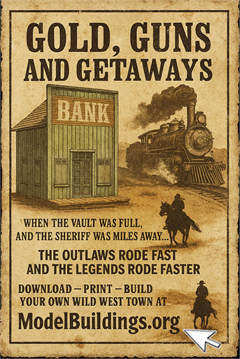Everything on model trains, model railroads, model railways, locomotives, model train layouts, scenery, wiring, DCC and more. Enjoy the world's best hobby... model railroading!
Questions about Using LED Lights as Locomotive Headlights
Aaron asks readers for advice:
“I have heard so many good things about LEDs, so am thinking about upgrading my N scale DCC diesel loco headlights, and maybe using them for ditch lights and markers. Does anyone have any tips for powering them independently, what type to use for each function, how to get a constant intensity from each light, other uses for LEDs etc. And any other tips appreciated. Thanks.”
8 Responses to Questions about Using LED Lights as Locomotive Headlights
Leave a Reply















LEDs are available in cool or warm white, the warm white imitates the older incandescent filament lighting.
Standard (focused) (flashlight type) LEDs produce a suitable beam, rather than the wide-angle strawhat type.
Various sizes are made, an N scale loco headlight would probably take about a 3mm LED. 2mm and 1.8mm are also available, but most can be filed down a little to fit.
If you are really clever and dextrous in your soldering, SMD LEDs are incredibly tiny, and can be fitted in the smallest spaces.
LEDs are polarised (voltage must be applied the right way round), so a diesel loco can have the headlight each end automatically lighting according to its direction. (diagram attached)
An LED must have a resistor connected in series with it to control the current, generally a 1 k resistor will be OK up to 12 V. (Higher resistance if you want dimmer light.)
But if your N locos are DCC, I would expect the headlight to be an LED already.
You will find the DCC decoder will put out constant, switchable power for the lights. Select the function on your controller to switch them on and off. Programming the CVs can allow various lighting effects. As per Franks comment above, LEDs are polarity and current sensitive. Too much power and the magic smoke escapes. Check the documents for the power output of the lightning circuits and use the appropriate size resistors for the LED you are using.
Aaron:
You have had almost the answers in the before posts. The only thing I can say to you is that you can have almost kind of leds here: http://www.led1.de. I know that this is here in Europe (Germany) but I tink you also can find it in US. If you are running N scale, I think it would be better to use SMD leds, because they can fit almost in any place inside your loco, but you need to have some skills in soldering those kind of devices. They are very sensitive to hot genereted by the soldering iron. So choose what´s the best for you.
About intensity, you also must remember that all kind of leds (not all, sorry) need to have a resistor in series with it to avoid burning the led. I have written “not all” because we have also in Europe a manufacturer Muldental Elektronic, also in Germany that sold not SMD leds, but the usual ones that don´t need any kind of resistor. They have one inserted inside the capsule, so no resistor is needed.
I hope this can help you.
Cheers,
Alvaro
Good Information from Aron Peter and Frank. I want to add one note that there is a positive and negative side to your LED’s. If you hook up one side to positive and the other to negative One way will not light and the other will. If you note the LED filament there are to different forms of the filament and it works one way If you hook it up in reverse should not hurt it It just won’t light. Just reverse the 2 leads and you will be fine. The resister doesn’t matter which side of the LED it is on. It just has to be in there.
Something I am working on, on my HO Engines is putting in step lights under the steps above the lighted step. To do it I may have to install the LED in the engine and fiber optics to each step. This is another possibility. One LED could light several fiber optics. Anyway it is a thought for some unique lighting opportunities. I am also getting materials together to power the green and yellow door lights on Amtrak’s Super-liners. I intend to have them go green when motion is started with the throttle and yellow when the train is stopped. This will simulate a door is open such as a station stop. To power them I am looking at magnetic wire connectors Simulating the power cords between the cars up to the engine and the signal from the engine, such as where the Mars light comes on when movement starts. I don’t have any drawings of it yet but planning in my head. Still in the planning stages. from Newman Atkinson
I have converted all my locomotives to LED’s. They work great and have a constant bright light at any speed. The schematic that Frank B. posted is correct. Wiring like that should bring you good results.
Upon installation you should use a 470 resister. Without the resister the LED will burn out instantly.
A lot has been said already, and I don’t disagree with any of it, but just a couple of things of mention. LED’s can also be used for street or building lighting or even connected to fibre-optic strands and used to light head/tail lamps on cars. You can get rolls of SMD LED’s already connected and embedded in a flexible self-adhesive rubber strip. Just cut to the desired length, wire up and stick to the inside of a building (on the ceiling obviously). They’re available in cool/warm white and various colours as well.
If you want to power street lighting or blocks of buildings, go to your local boot sale/flea market. There is almost always someone who has a box full of old mobile/cell phone chargers for pennies/cents each. Cut off the connector end, wire into an electrical connector (chocolate block or similar) and then connect that up to your LED circuit. Make sure the charger can deliver enough current for the circuit you want to supply. 3mm LED’s normally run at about 20mA and chargers normally supply 200mA or more. 200mA divide by 20mA equals 10 LED’s. Works great for me.
I would like to run LED street lights off of my garden railway track. As leds only work in one direction can any one tell me what I need in the way of an electrical switch (relay) to enable the lights to work when I change direction